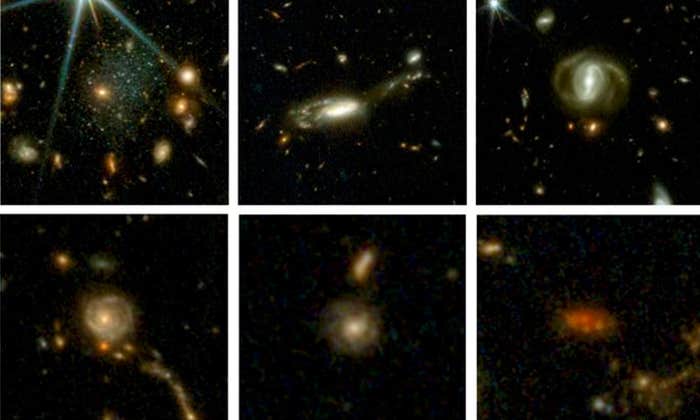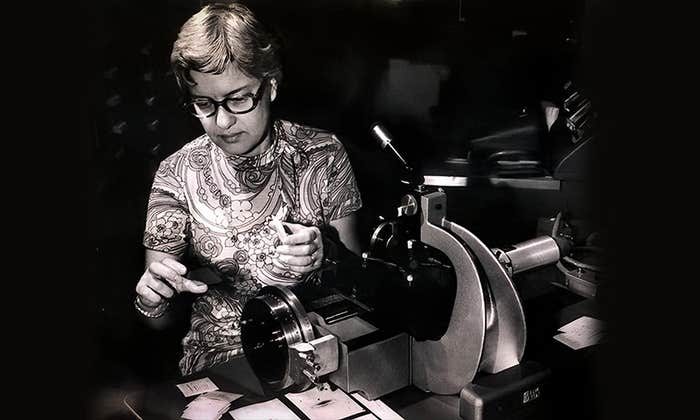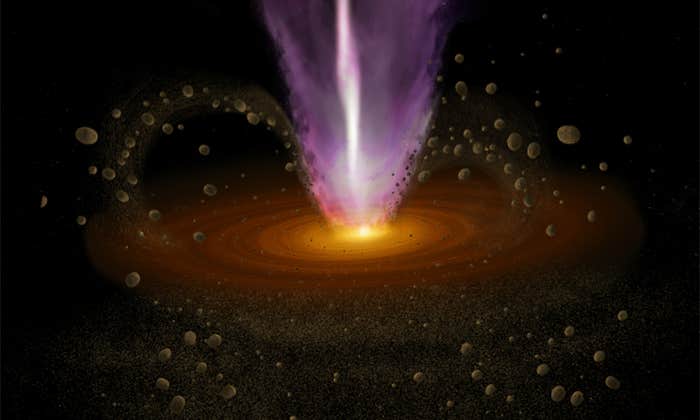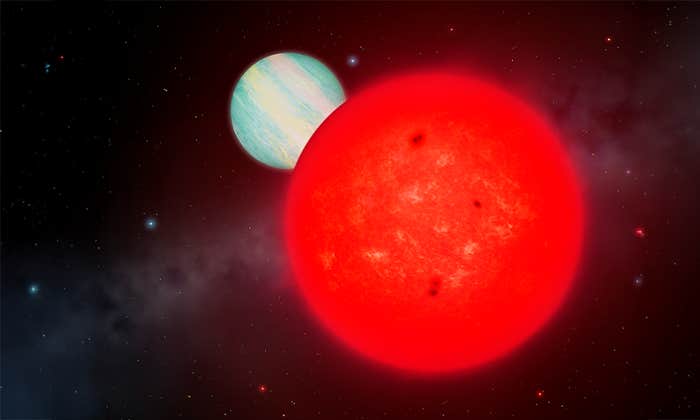The young physicist sits at his computer, watching for signals from Cygnus. His name is Christopher Toth, and his white lab coat is too big for him. Christopher speaks with calm clarity. His manner is modest, gracefully gentle, and I wonder if this comes in some way from spending your days thinking through time so deep it stretches to the birth of the universe.
Along the walls of the laboratory, at intervals of every 15 feet or so, black-and-yellow warning tape marks the outlines of what look like potential doorways, rising only to thigh level. Above each taped outline, a long-handled axe with a splitter blade is held in two hooks.
Salt has very low gamma radiation. Salt is a good insulator. Salt is radio-pure. Salt is an excellent substance in which to encase yourself if you want to study weakly interacting massive particles. But salt is also highly plastic. Salt flows over time. It creeps around. It sags. If you cut a chamber out of a seam of halite with 3,000 feet of bedrock above it, that chamber will slowly distort. The ceiling will dip, the sides will bulge. Gravity wants that space back. So the scientists working in the Boulby laboratory know they are operating in a temporary zone, with limited years of safe life. Deep time must be studied fast.
“Those are your emergency exits in case of a sudden slump in the halite,” says Christopher, mimicking the hand gestures of a flight attendant explaining the safety protocols, and pointing to the doorways marked with warning tape, “here, here … and here. If the lab begins to collapse, you grab an axe, hack your way through the lab wall, then hack your way out through the salt to safety.”
He pauses, smiles. “Well, that’s the theory, at least.”
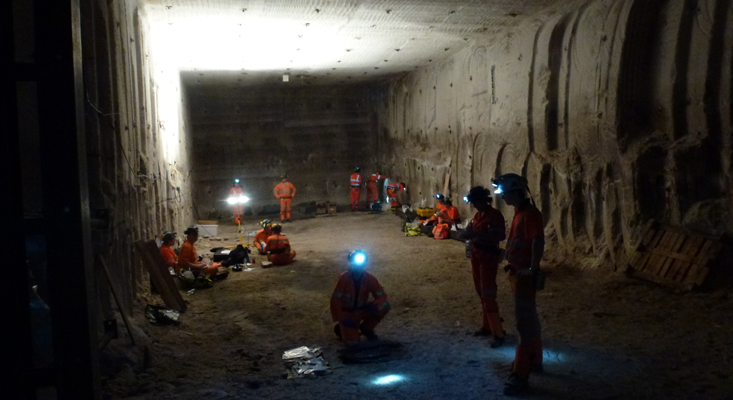
Several different kinds of underground experiments are presently taking place in the laboratory. One assays rock samples in order to research techniques for the long-term burial of radioactive waste. Another investigates a technology known as “muon tomography,” which makes use of highly penetrating charged particles (muons) produced by cosmic rays from space. Because of their ability to pass deep into rock, muons allow sunken structures such as the interiors of volcanoes and the hollow hearts of pyramids to be perceived. Muons offer a way of seeing through stone. These are all remarkable experiments. But the jewel in the experimental crown of the Boulby laboratory is DRIFT.
Christopher walks me toward a large object at one side of the laboratory. “This is my underground crystal ball,” he says—flourishing his hands like a magician revealing a trick—“also known as the Time Projection Chamber.”
From the outside, the magnificently named Time Projection Chamber is disappointing to look at. Black bin liners are taped scruffily around a large metal-clad box.
“I see that bin bags make up the vital outer layer of your crystal ball,” I say.
“You mock,” replies Christopher, “but duct tape and bin bags have proved crucial to more scientific breakthroughs than you’d imagine.”
He explains the experiment to me. “We know dark matter is massy. Massively massy. So its particles, even though they’re invisible to us, have mass, and if they have mass then they must at least occasionally collide with particles we can see. These collisions send nuclei scattering. Our first goal with DRIFT is to detect these collisions, and follow the nuclei as they scatter.”
He pauses. I wait. Trillions of neutrinos pass through our bodies and on through the Earth’s bedrock, its mantle, its liquid innards, its solid core.
Does it change the way the world feels? Knowing that 100 trillion neutrinos pass through your body every second, that countless such particles perforate our brains and hearts?
“Imagine watching a game of billiards in which the red balls are visible but the white isn’t. Suddenly you see the red ball—an electron—move across the baize. By plotting the red ball’s path, you might be able to backtrack, as it were, the path of the invisible white ball—the WIMP—that struck it. And from this, you might be able to learn more about the direction, mass, and qualities of that white ball. We’re looking to do this enough times, and with enough precision, to provide the signature of a dark-matter halo.”
At the core of the DRIFT device is a steel vacuum vessel a cubic meter in volume, criss-crossed by a meshwork of ultra-thin, highly charged wires spaced a millimeter apart. If a WIMP collides with the nucleus of an atom of ordinary matter inside the chamber, it causes an ionization track, which the meshwork of wires both intensifies and records. The track can therefore be reconstructed in three dimensions, providing information about the type and origin of the colliding particle. The wires are held within a low-pressure gas, the low-pressure gas within a conductive chamber, the conductive chamber within a steel neutron shield—and the whole unit is held in a band of halite left by the evaporation of an ancient sea.
I will learn over the years ahead that many such Chinese-box structures, with their multiple containment protocols, characterize storage procedures in the underland, from the falcon-headed Canopic stone jars of ancient Egyptian burial practice—into which were placed the vital organs of the dead, and which were themselves encased in a painted wooden chest, itself encased in a tomb, itself encased in a pyramid—to the concentric sheathing of spent uranium pellets from nuclear reactors; the pellets placed within rods of zirconium, the rods encased in a copper cylinder, the copper cylinder encased in an iron cylinder, the iron cylinder encased in bentonite clay rings, and the rings encased in the bedrock of a deep geological storage facility, sunk thousands of feet into gneiss, or granite, or salt.
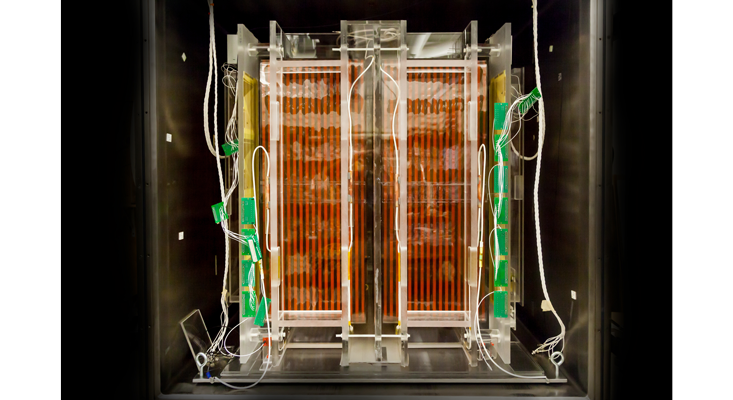
Christopher leads me to his desk. The screensaver image on his computer is of the turquoise waters of Lake Louise in the Canadian Rockies. He shows me a diagram representing data returns from the Time Projection Chamber. It has lines of different bright colors, across which a fine black streak runs at an angle.
“This diagonal line is the path of an alpha particle,” Christopher says, following it with his little finger. “He’s a bludgeoning, portly gentleman who comes barreling through our experiment, making a lot of noise as he goes. He’s not of interest to us, except insofar as identifying his signal helps us know what we’re not looking for.”
“What we’re trying to hear, instead, are the quiet whispers behind his boisterousness. Not even whispers, in fact; more like the faintest of breaths—of breathing. Down here in the salt is about the only place you could hear such breath. That breath is the sound of a weakly interacting massive particle passing through—and it leaves a fine trace. What we think is a WIMP-collision looks more like two small blips, one on each of two channels.”
With his fingernail he picks out two dots: one on a yellow line, one on pink. He pauses. His screensaver changes to an over-saturated image of a white-sand beach with palm trees, lapped by a lapis-lazuli sea. The WIMP wind from Cygnus blows through our bodies.
“This data is very beautiful once you get used to it,” he says. I nod in agreement.
What we’re trying to hear, instead, are the quiet whispers.
“Right now,” Christopher says, “you are looking into the absolute smallness of the universe with pinpoint accuracy, peering down at the most minute of scales. Those colored lines are our magnifying lens.”
Then he says—as if the phrase has just entered his head without warning, scoring a trace as it passes through—“Everything causes a scintillation.” He pauses.
“Why are you searching for dark matter?” I ask.
“To further our knowledge,” Christopher replies without hesitation, “and to give life meaning. If we’re not exploring, we’re not doing anything. We’re just waiting.”
He pauses again. I wait. The screensaver on his computer changes to Yosemite in the autumn, with early snow on the top of El Cap. Christopher does not speak.
“Is the search for dark matter an act of faith?” I ask him.
He waits for me to elaborate—he has heard the question before, wants more before he answers. His screensaver changes to the desert dunes at Sossusvlei in Namibia.
If I detected proof of a deity, I would distrust that deity on the grounds that a god should be smarter than that.
I think of Rievaulx Abbey west of Boulby, where in a fertile river valley Cistercian monks founded and built a space in which to hold Mass. Out of ironstone they made an airy structure of soaring buttresses and vaulted ceilings. Their abbey was one among a network of such sites spread around the world, in which prayers were offered to a presence disinclined to disclose itself to the usual beseechings.
On the hillsides above the abbey geological forms known as “slip-rifts” slowly open and close in the rock, emitting warm air from deep within the earth, such that on cold days the hillside appears to be breathing—as if the land itself were alive. Thousands of years before the Cistercians arrived in those valleys, Neolithic and Bronze Age peoples entered the darkness of the slip-rifts to carry out rituals that may have been sacrificial and were surely devotional, interring body parts amid the stones of the rifts; another kind of annihilation product.
I remember the Wind Cave system in the Black Hills of South Dakota, sacred to the Lakota Sioux people and close to the American dark-matter detection laboratory set deep in the worked-out gold mine. From the opening to Wind Cave, which extends for more than 130 miles below ground, air rushes or is drawn with such force that it can strip hats from heads. In the Lakota creation stories it is from Wind Cave that humans first emerge into the upper world, where they are astonished by color and space.
“My sense,” I say to Christopher, “is that the search for dark matter has produced an elaborate, delicate edifice of presuppositions, and a network of worship sites, also known as laboratories, all dedicated to the search for an invisible universal entity which refuses to reveal itself. It seems to resemble what we call religion rather more than what we call science.”
“I grew up as a very serious Christian,” Christopher says. “Then I lost my faith almost entirely when I found physics. Now that faith has returned, but in a much-changed form. It’s true that we dark-matter researchers have less proof than other scientists in terms of what we seek to discover and what we believe we know. As to God? Well, if there were a divinity then it would be utterly separate from both scientific enquiry and human longing.”
He pauses again. It is not that this thinking is hard for him—he has moved down these paths before—but that he is picking each word with care.
“No divinity in which I would wish to believe would declare itself by means of what we would recognize as evidence.” He gestures at the data read-out. “If there is a god, we should not be able to find it. If I detected proof of a deity, I would distrust that deity on the grounds that a god should be smarter than that.”
“Does it change the way the world feels?” I ask him. “Knowing that 100 trillion neutrinos pass through your body every second, that countless such particles perforate our brains and hearts? Does it change the way you feel about matter—about what matters? Are you surprised we don’t fall through each surface of our world at every step, push through it with every touch?”
Christopher nods. He thinks. His screensaver changes to the limestone towers at Guilin, seen near dusk such that they are backlit in ways that are considered widely appealing on Instagram and other large-scale image-sharing platforms.
“At the weekends,” Christopher says, “when I’m out for a walk with my wife, along the cliff tops near here, on a sunny day, I know our bodies are wide-meshed nets, and that the cliffs we’re walking on are nets too, and sometimes it seems, yes, as miraculous as if in our everyday world we suddenly found ourselves walking on water, or air. And I wonder what it must be like, sometimes, not to know that.”
He pauses, and it is clear that he is thinking now beyond the confines of the salt cavern, beyond even the known limits of the universe.
“But mostly, and in several ways, I’m amazed I’m able to hold the hand of the person I love.”
Robert Macfarlane is the author of prize-winning and bestselling books about landscape, nature, people and place, including Mountains of the Mind: A History of a Fascination (2003), The Wild Places (2007), The Old Ways (2012), Holloway (2013, with Stanley Donwood and Dan Richards), Landmarks (2015), The Lost Words: A Spell Book (with the artist Jackie Morris, 2017) and Underland: A Deep Time Journey (2019).
Reprinted from Underland by Robert MacFarlane. Copyright © 2019 by Robert MacFarlane. With permission of the publisher, W.W. Norton & Company, Inc. All rights reserved.
Lead photo: Christopher Toth in an excavation site at the Boulby Underground Laboratory. The site now hosts large-scale detectors of dark matter, the elusive material that constitutes most of the universe.





















